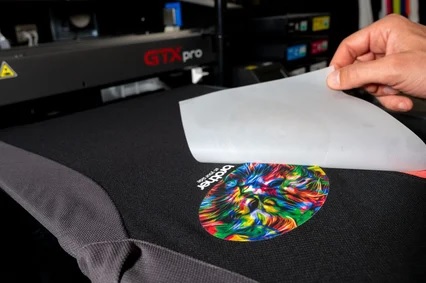Table of Contents
- Introduction to Direct-to-Film Printing
- History and Evolution of Printing Techniques
- Advantages of Direct-to-Film Printing
- How Direct-to-Film Printing Revolutionizes Custom Apparel
- Examples of Unique Fashion Pieces Created with DTF
- Sustainability Aspects of Direct-to-Film Printing
- Conclusion and Future Trends
Introduction to Direct-to-Film Printing
Direct-to-film (DTF) printing is a cutting-edge technique that has been making waves in the fashion industry. Unlike traditional methods, a DTF printer offers unparalleled versatility and vibrant colors that appeal to designers and consumers alike. By transferring designs directly onto films before pressing them onto fabrics, this method ensures high-quality prints that stand out, providing a level of customization and detail that is difficult to achieve with other printing techniques.
This creative method is gaining popularity quickly among fashion labels who want to provide sophisticated and unique designs. Many find it to be an appealing alternative because it can print on a variety of textiles without sacrificing quality. DTF printing functions flawlessly on a variety of materials, including mixes and cotton. This makes it an adaptable option for a wide range of applications. Not only can technology help big fashion companies, but it also helps tiny firms make distinctive, high-quality products quickly and effectively.
History and Evolution of Printing Techniques
From screen printing to digital prints, the fashion world has witnessed a remarkable evolution of printing technologies. In the decades past, screen printing was the go-to method for mass-producing designs. This method involved creating a stencil (or screen) and using it to apply layers of ink on the printing surface. While effective, it required significant setup time and was not ideal for complex or multi-colored designs. Variations were hard to implement, and each design change meant a new screen, adding to the time and cost.
As technology advanced, digital methods like Direct-to-Film printing emerged, bringing more intricate and durable designs to fabric. This progress made it easier to produce high-quality prints with fewer resources, paving the way for more creative and personalized clothing options. The journey from manual screen techniques to automated digital methods reflects the technological advancements aimed at meeting the growing demands for efficiency, quality, and complexity in designs.
Advantages of Direct-to-Film Printing
Direct-to-film (DTF) printing offers several advantages, including high quality and durability, ease of use, and cost-effectiveness. DTF prints are known for their durability and resistance to wear and tear, making them ideal for everyday wear or fabric items. The process requires less setup and maintenance compared to traditional methods, as the film can be transferred to the fabric using a heat press, resulting in quicker turnaround times. DTF printing also reduces waste, making it more economical for short runs and smaller batches. This makes it a practical option for designers and small businesses, as it allows for on-demand production and significant cost savings, particularly for limited-edition items.
How Direct-to-Film Printing Revolutionizes Custom Apparel
The advent of DTF printing has transformed the custom apparel sector. Fashion designers can now experiment with complex patterns and colors that were once impossible to achieve. This technology has empowered small businesses to offer personalized apparel, catering to niche markets and individual preferences. By allowing for small production runs without sacrificing quality or design complexity, DTF printing opens up new possibilities for customization and innovation.
One significant benefit is the ability to print on demand, which helps reduce inventory costs and allows for more spontaneous design changes. This flexibility is particularly advantageous for emerging designers aiming to produce limited-edition collections without the financial burden of large minimum order quantities. Moreover, DTF printing supports a wide range of fabrics, enabling designers to diversify their product offerings without the need for different printing technologies.
Examples of Unique Fashion Pieces Created with DTF
DTF printing has given birth to several unique fashion pieces, from bespoke t-shirts to intricate dresses. These prints are trendy in streetwear, where customization is key. Think of limited-edition designs that resonate with subcultures, making each piece a statement of personal style. Designers can create exclusive collections that appeal to a targeted audience, adding value to their brand.
Fashion brands can utilize DTF printing to create one-of-a-kind items that attract fashion enthusiasts looking for exclusive pieces. This has also opened new avenues for collaborations between artists and fashion designers, resulting in visually stunning apparel that combines art and fashion seamlessly. Whether it’s a graphic tee featuring an emerging artist’s work or a high-fashion piece adorned with complex patterns, DTF technology makes it possible to bring these creative visions to life with impeccable detail and color fidelity.
Sustainability Aspects of Direct-to-Film Printing
DTF printing, in addition to its creative and economic benefits, also contributes to sustainability in the fashion industry. By utilizing water-based inks and minimizing cloth waste, DTF printing reduces environmental impact. This environmentally friendly strategy aligns with the growing need for sustainable fashion, as water-based inks are safe for the environment and non-toxic, unlike traditional printing techniques that often use dangerous chemicals and generate large amounts of waste.
Furthermore, printing only what is required reduces overproduction and the environmental impact of the fashion industry. DTF printing is becoming a more common tactic used by brands that are dedicated to sustainability to encourage moral and conscientious fashion practices. It is being able to manufacture high-quality goods on-demand, resulting in less waste and unsold goods, which encourages more environmentally friendly consumer habits and gives hope for a more sustainable future.
Conclusion and Future Trends
In the fashion business, direct-to-film printing is revolutionizing the game by providing previously unheard-of chances for creativity and innovation. We anticipate even more exciting advancements in technology as it develops further, opening up the possibility of bespoke, premium fashion for all. DTF printing is a desirable option for contemporary fashion designers and companies looking to stand out in a crowded market because of its quality, sustainability, and adaptability.
To sum up, the ongoing developments in DTF printing technology hold up the possibility of providing designers with new avenues for the production of distinctive, eco-friendly, and customized clothing items that satisfy a wide range of consumer tastes. The fashion sector can reap advantages such as decreased waste, enhanced personalization, and more straightforward realization of creative designs by using this cutting-edge technology.



